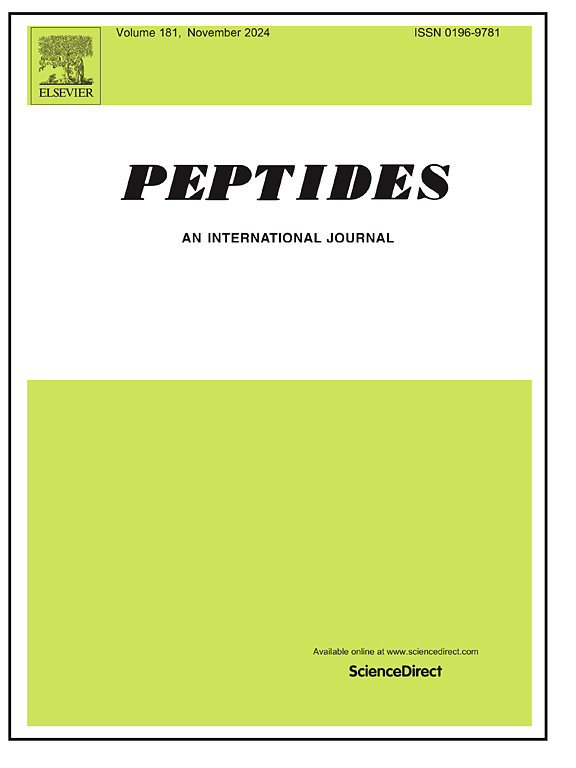在高脂肪饮食的大鼠中,IGF-1通过上调Na+/K+- atp酶活性和调节关键信号通路,有助于心血管保护
IF 2.9
4区 医学
Q3 BIOCHEMISTRY & MOLECULAR BIOLOGY
引用次数: 0
摘要
本研究考察了胰岛素样生长因子-1 (IGF-1)改善肥胖大鼠心脏钠/钾腺苷三磷酸酶(Na+/K+- atp酶)的表达和功能,减轻心脏肥厚的能力。成年雄性Wistar大鼠分别饲喂标准饮食和高脂肪饮食12周。在安乐死前24 小时,半数HF大鼠给予IGF-1(50 μg/kg, i.p)。IGF-1处理增加:Na+/K+- atp酶活性、磷酸化和总Na+/K+- atp酶α1亚基的表达、IGF-1受体β /胰岛素受体β Tyr1131/Tyr1146、胰岛素受体底物-1 (IRS-1) Tyr1222、哺乳动物雷帕霉素靶蛋白(mTOR) Ser2481、蛋白激酶B (Akt) Ser473和2型血管紧张素II (AngII)受体(AT2R)的表达。相反,IGF-1降低了Ser307位点磷酸化的IRS-1、Ser2448位点磷酸化的mTOR、Thr421/Ser424位点核糖体蛋白p70 S6激酶(S6K)的水平、心脏中1型Ang II受体(AT1R)的表达以及肥胖大鼠血清中Ang II的水平。IGF-1处理降低肥胖大鼠心脏质量,升高α-肌球蛋白重链(MHC) mRNA表达和α/β MHC比值。本研究结果表明,肥胖大鼠给予IGF-1可减少HF饮食的不良影响,可能是通过降低Ang ii介导的mTOR/S6K激活和增强IRS-1/Akt通路,从而促进心脏Na+/K+- atp酶活性并减轻心脏肥厚。本文章由计算机程序翻译,如有差异,请以英文原文为准。
IGF-1 contributes to cardiovascular protection in obesity by upregulating Na+/K+-ATPase activity and modulating key signaling pathways in rats on a high-fat diet
This study examined the ability of insulin-like growth factor-1 (IGF-1) to improve the expression and function of cardiac sodium/potassium adenosine triphosphatase (Na+/K+-ATPase) and reduce heart hypertrophy in obese rats. Adult male Wistar rats received a standard diet or a high-fat (HF) diet for 12 weeks. A bolus injection of IGF-1 (50 μg/kg, i.p.) was administered to half of the HF rats 24 hours before euthanasia. IGF-1 treatment increased: the activity of Na+/K+-ATPase and expression of phosphorylated and total Na+/K+-ATPase α1 subunit, the phosphorylation of IGF-1 receptor β /insulin receptor β at Tyr1131/Tyr1146, insulin receptor substrate-1 (IRS-1) at Tyr1222, mammalian target of rapamycin (mTOR) at Ser2481, protein kinase B (Akt) at Ser473 and the expression of type-2 angiotensin II (AngII) receptor (AT2R). Conversely, IGF-1 reduced the levels of IRS-1 phosphorylated at Ser307, mTOR at Ser2448, ribosomal protein p70 S6 kinase (S6K) at Thr421/Ser424, and the expression of type-1 Ang II receptor (AT1R) in the heart, as well as the serum levels of Ang II in obese rats. IGF-1 treatment reduced cardiac mass and elevated mRNA expression of the α-myosin heavy chain (MHC), and the α/β MHC ratio in the hearts of obese rats. The results of this study suggest that the administration of IGF-1 to obese rats reduces the adverse effects of HF diet, potentially by lowering Ang II-mediated activation of mTOR/S6K and enhancing the IRS-1/Akt pathway, which promotes Na+/K+-ATPase activity in the heart and diminishes cardiac hypertrophy.
求助全文
通过发布文献求助,成功后即可免费获取论文全文。
去求助
来源期刊

Peptides
医学-生化与分子生物学
CiteScore
6.40
自引率
6.70%
发文量
130
审稿时长
28 days
期刊介绍:
Peptides is an international journal presenting original contributions on the biochemistry, physiology and pharmacology of biological active peptides, as well as their functions that relate to gastroenterology, endocrinology, and behavioral effects.
Peptides emphasizes all aspects of high profile peptide research in mammals and non-mammalian vertebrates. Special consideration can be given to plants and invertebrates. Submission of articles with clinical relevance is particularly encouraged.
 求助内容:
求助内容: 应助结果提醒方式:
应助结果提醒方式:


